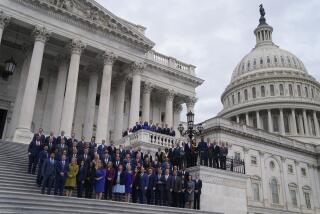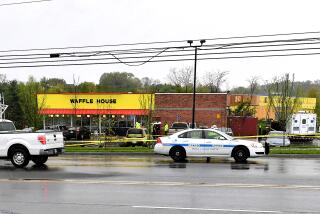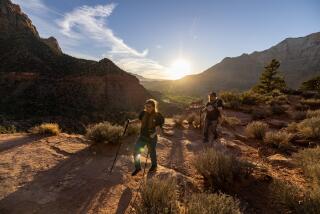PERSPECTIVE ON RELIGION : True Liberty Cherishes Difference : Our ethnic diversity includes forms of worship that immigrants brought with them and adapted to American life.
- Share via
The Statue of Liberty now symbolically raises her torch of freedom to the East as well as to the West, but it has not always been so. The Asian exclusion acts, and later the national origins quotas, effectively limited immigration from Asia until late in this century. Only with the passage of the 1965 Immigration Act did the ethnic makeup of the United States finally come to include substantial communities from South Asia, Southeast Asia and East Asia. The 1990 census reveals how much the Asian population has grown--up 194% from 1980 in Minnesota, 208% in Georgia, 245% in Rhode Island. Residents of any major American city count Asian-Americans among their neighbors.
Along with our new ethnic diversity, the religious landscape of America is also changing. Not far from the starting point of the Boston Marathon, the Hindus of New England have consecrated a temple to the goddess Lakshmi. Outside Toledo, Ohio, a striking new mosque rises from the cornfields. In Stroudsburg, Pa., Hindu teen-agers come to a Hindu heritage summer camp. Jains, Muslims and Sikhs also have summer camps for their youngsters--in the Poconos, the Sierra and upstate New York. But the dimension of religion has been absent from the debate on multiculturalism. “We the people” are not only Christian and Jewish, but Muslim, Buddhist and Hindu. What will this mean to our current national identity crisis?
The American flag, the symbol of the liberty we celebrate on July 4th, flies in places with which most Americans are not yet familiar. For example, at the Hsi Lai Buddhist temple in Hacienda Heights, east of downtown Los Angeles, Old Glory flies over the broad staircases that bring thousands of Chinese-American Buddhists up to the elegant Main Shrine, its walls covered with 10,000 Buddhas. In New York City, the flag is carried every year by members of the Sikh community in their festive Vaisakhi Day parade through the streets of Manhattan. The flag is raised every Saturday in North Hollywood as the weekend religious school begins at Wat Thai. The Stars and Stripes have a place inside the Thai temple, along with the flag of the State of California, to one side of the image of the Buddha.
The ethnic diversity of Los Angeles is reflected in its Buddhist community, but always with an American twist. On May 10, at the annual celebration of Buddha’s birthday, the American flag was posted in the stately rooms of a former Masonic Hall, now the Kwan Um Sa Buddhist Temple, near downtown Los Angeles. A tall, golden image of Buddha stood between the American flag and the Korean flag. On the wall above was a banner that read, in Korean, “Pray for the Los Angeles Disaster of April 29.”
By contrast, no American or other national flag flies in the prayer rooms of any of the nation’s 1,000 mosques. Muslims place no symbol, national or religious, in the place where prayer is offered to God. Outside the prayer room, however, the U.S. flag is posted in the classrooms of the Orange Crescent School, operated by the Islamic Society of Orange County. In the social hall of the mosque in Quincy, Mass., built in the shadow of the Quincy shipyards not far from the birthplace of John Quincy Adams, the American flag is flown on special occasions, along with the Islamic flag and the flag of the Commonwealth of Massachusetts.
Islam is now an American religion. The Islamic Society of North America meets yearly on Labor Day weekend. The thousands of Muslim men, women and youth who attended lastyear’s meeting in Dayton, Ohio, addressed the theme, “Creating an Islamic Environment in North America.” One year ago, an African-American Muslim, Siraj Wahaj of Brooklyn, became the first Muslim to open a daily session of the House of Representatives with prayer. Last February, W. Deen Muhammad followed in the Senate. Today, there are more Muslims in the United States than Congregationalists, more Muslims than Episcopalians.
On this July 4th, the Hindus of Flushing, N.Y., observed the 15th anniversary of the Ganesha Temple. Most of America’s Hindu temples are invisible--in suburban homes, rented halls, office buildings and converted churches. Along with the Pittsburgh temple, this is the first to have been built from the ground up. It was consecrated on July 4, 1977, as a tribute to American Independence Day. Now there are at least a dozen such temples in America, designed by Hindu temple architects and built by American engineering firms. When Boston’s Sri Lakshmi temple was dedicated in 1990, the waters of consecration came not only from the sacred Ganges in India, but from the Missouri, the Mississippi and the Colorado rivers.
The new religious landscape of America requires that all of us think more energetically about the meaning of pluralism. Our coins are minted with the motto E Pluribus Unum-- “Out of many, one.” However, the tension between assimilationism and pluralism has been continuous in American history. The assimilationist image is the melting pot. As turn-of-the-century playwright Israel Zangwill put it, “America is God’s crucible, the great Melting-Pot where all the races of Europe are melting and re-forming.”
In the pluralist view, however, the right to be different and stand against the majority is not only guaranteed, but cherished. For the pluralist, diversity is not divisive, but is the very stuff out of which the strong fabric of American culture is created. The creation of that fabric will continue to require work. While cultural and ethnic traditions of the new immigrants may change in the American context, religious traditions do not melt.
America has not only a multicultural future but a multireligious one. If it is to have any positive content, “pluralism” must be more than just plurality. We may fly the same American flag in churches and synagogues, in Buddhist temples and Islamic schools, and yet remain isolated, with virtually no knowledge of each other. This is not pluralism. Pluralism requires something of us--active engagement and a level of public religious literacy and inter-religious dialogue that we have not yet begun to achieve.
Who are we, all of us, who fly the flag and cherish the liberty it stands for, if we do not make it our responsibility to know one another?
More to Read
Sign up for Essential California
The most important California stories and recommendations in your inbox every morning.
You may occasionally receive promotional content from the Los Angeles Times.










